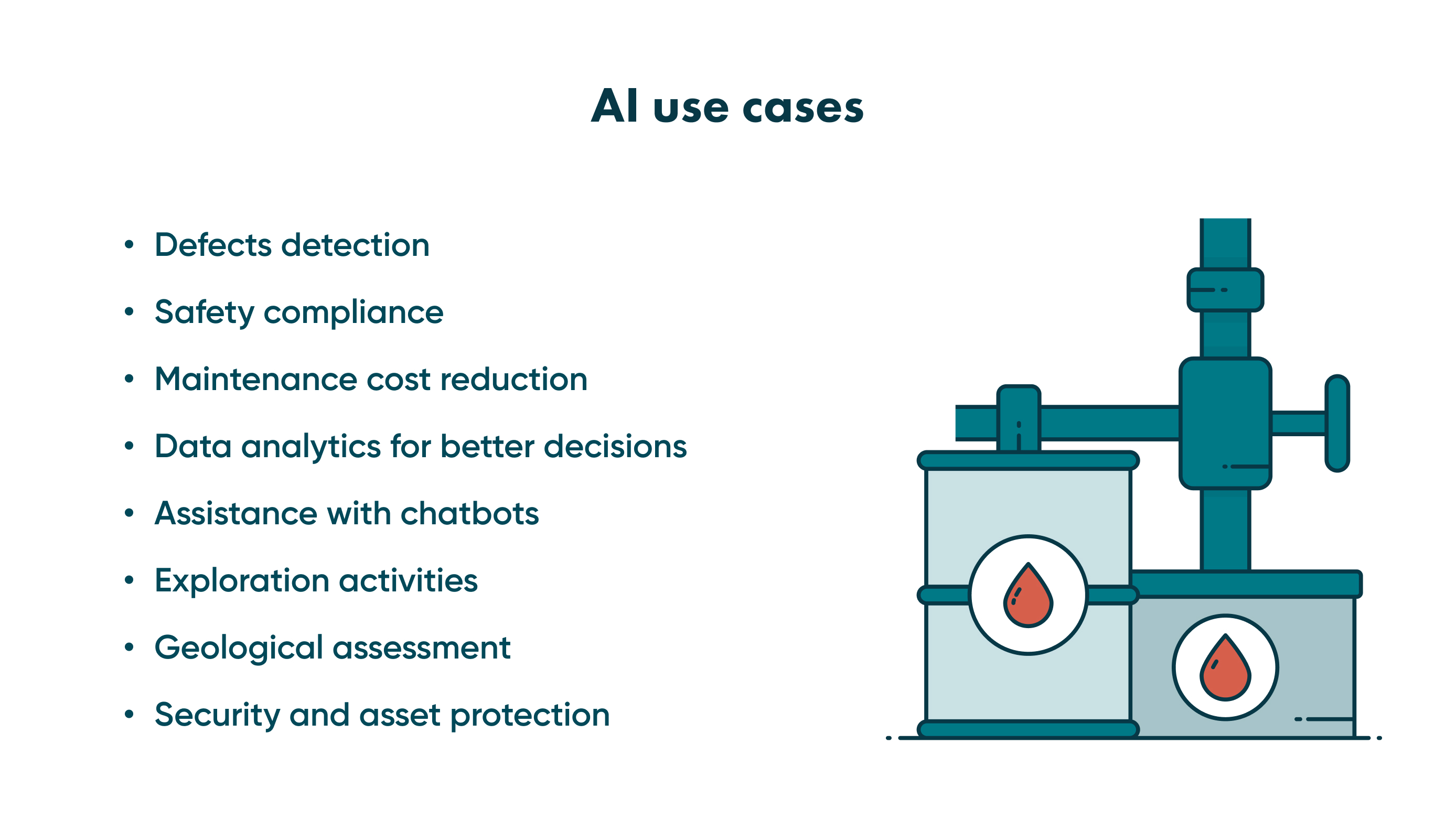AI in Oil and Gas: The Technology Revolutionising the Industry


Artificial intelligence (AI) has already made significant strides in revolutionising various industries, including healthcare, finance, and retail, among others. Now, this new technology is impacting sectors beyond B2C, as it’s becoming increasingly common to find AI in oil and gas software applications.
By leveraging the power of machine learning (ML) algorithms and other AI technology, the industry is poised to improve efficiency, reduce costs, and enhance safety in all aspects of exploration, production, and distribution.
The oil and gas sector is a complex and highly technical field involving many different stages and processes. AI can be implemented across all stages to optimise the process and generate valuable insights.
Our article will reveal more details and practical insights for your business.
The impact of AI on the oil and gas industry
In 2019, the oil and gas AI market was valued at 2 billion USD. According to Business Wire, the market is expected to reach 3.81 billion USD by 2025 at a CAGR (Compound Annual Growth Rate) of 10.96%.
AI ML in the oil and gas industry is used for data analysis and interpretation as well as for forecasting future trends and production spikes.
Artificial intelligence, the internet of things (IoT), and cloud computing are gaining momentum in the oil and gas sector.
Yet, in the past, the industry lacked professionals with the necessary expertise. Therefore, oil and gas enterprises should take the time to hire AI professionals to create tools, train staff members, and help integrate AI-based solutions into their daily operations.
AI's impact on the oil and gas sector has huge potential, especially because the goal of this technology is to simplify and streamline production and exploration processes.
Not to mention the fact that digitalisation, automation, and data analytics can help companies align their goals to market trends while improving their operations.
Benefits of AI
As the impact of AI on the industry is so significant, let's take a moment to focus on the advantages of AI in the oil and gas market.
Downtime reduction
The best way to prevent problems is to detect them as early as possible.
This type of preparation can reduce downtime, increase production, and increase profits by moving from a reactive to a preventive approach, and AI allows you to do exactly that.
Optimisation
Optimising the performance of a large number of wells is time-consuming and usually relies on rules of thumb rather than accurate evaluation.
Instead, a combination of physics-based models and ML can be used to continuously review well performance and optimise operating parameters for all wells.
Accurate production estimation
In today's oil and gas industry, much of a well's production is allocated back to the well from sales or tank levels. Unfortunately, these estimates are based on stale well-test data sets that do not reflect actual production values.
Effective management requires more detailed production data which can be obtained using AI, so that reserve levels can be assessed and proper prioritisation of field resources can be made.
Decision-making shift
A significant benefit of using AI in oil and gas is that it can help optimise the entire value chain by adjusting operations to get the most out of any given asset. In other words, it can use assets and resources to their fullest.
As a result, artificial intelligence can help oil and gas companies make more informed decisions about using their resources.
For instance, if a methane tank is leaking, an AI system can factor in the price of natural gas and assess whether it would be more cost-effective to fix the leak or simply let it outgas and replace the tank at the next upgrade.
Upgraded logistics management
The logistics and transportation needs of the oil and gas industry are complex because there are too many nodes and decision centres to consider from beginning to end.
Artificial intelligence in the oil and gas industry helps businesses through the planning and execution of transportation services. In short, this technology ensures better coordination and aligns all stakeholder’s individual operations so that shipping time is reduced.
Data analysis
Oil and gas companies have their warehouses and facilities in several locations globally, so it is essential to manage them efficiently. With the implementation of artificial intelligence, these corporations get access to data from all locations in one place.
This helps them to monitor and manage all plants remotely.
However, sometimes data records might need to be completed, so it becomes crucial to digitise and assess them before utilising them.
With the help of AI tools, oil and gas companies can digitise records and automate data analysis. This helps identify issues like faults in equipment or defects in pipelines.
What software is required for your oil and gas business? Contact Go Wombat to discuss the details.
AI applications in the oil and gas industry
What use cases does AI have in oil and gas? How exactly can artificial intelligence be applied in the oil and gas sector? Let’s take a look.

Defects detection
One challenge in the oil and gas industry is identifying improper pipeline threadings. Defects found at the end of the production line may cost vast budget resources. For example, an imperfection in an error-prone mechanism or in an oil pipeline installed into production could result in severe damage.
AI adoption is a cheaper option compared to potential losses due to defects.
Deploying computer vision in manufacturing can reduce defects and improve product quality. In addition, AI-powered defect detection solutions are cost-effective and can be easily implemented into existing processes.
Safety compliance
AI in the oil and gas industry especially proves its usefulness when it comes to safety.
Oil and gas plants are locations where all workers must follow standards and strictly observe all precautionary measures. For example, employees must wear personal protective equipment when entering the workplace.
Safety standards enforced by law require companies to ensure the well-being of their employees. Failure to adhere to these standards can result in hefty fines.
A computer-vision solution powered by AI can monitor a work site to ensure workers follow safety procedures. The camera data is fed into an AI algorithm that will analyse it and send alerts when deviations occur.
This solution can alert management even if there is a tiny deviation in safety-measures compliance.
Maintenance cost reduction
Oil and gas extraction activities often depend on pipelines transporting the extracted resources to the central repository.
Environmental conditions can cause damage to these components. Corrosion of the materials can cause deformation, resulting in faded threading or weakening of the pipeline itself.
Ignoring this problem can result in catastrophic damages halting the entire production process.
AI combined with IoT in the oil and gas sector may prevent such incidents.
IoT solutions with AI algorithms can detect corrosion signs by analysing specific parameters. They can identify the probability level of corrosion occurrence and send alerts to pipeline operators.
As a result, preventive maintenance can be performed, which leads to cost reduction and better performance.
Data analytics for better decisions
Oil and gas companies deal with large amounts of data from manufacturing processes but need the proper analytics tools to draw insights from them.
These corporations can analyse data manually, but this is a limited option due to its time and cost. Furthermore, no amount of human labour can get all the data produced in a single day of error-free operations.
Big data apps with artificial intelligence can be used to collect information, aggregate it, put it into segments, and reveal inconsistencies to make accurate predictions and decisions.
AI algorithms study data from the sensors and machinery of a plant or entire geoscience landscape to extract real-time analytics, which is used to generate intelligent suggestions based on business needs.
Specialists can now better understand the overall operations and make better strategic decisions. Therefore, they improve operations efficiency and reduce possible failures.
Assistance with chatbots
Field operators can benefit from chatbots and virtual agents, which can be even more useful by adding a voice-enabled component.
Operators must keep their hands free while working, as they often move from one place to another. Voice-enabled chatbots can assist with questions and status reports using hands-free voice commands.
Chatbots are a valuable source of information and can pull real-time data from various sources, handle tasks such as calling for help and provide relevant instructions from the internal database.
Furthermore, operators can receive additional support from chatbots, providing real-time access to critical data. For instance, operators facing a machine failure can ask a chatbot how to fix it or any related questions.
Exploration activities
AI in oil and gas exploration can play a vital role. However, the traditional exploration process is costly, exhaustive, and not precise as specialists would like.
One solution to this is to adopt autonomous AI-powered robots that will be involved in deep exploration activities.
Today, oil and gas companies already use drones to create seismic images, and then processing algorithms extract information from them.
All collected data is used for detailed exploration, increasing accuracy and minimising human risks.
Geological assessment
In 2020, the Wadia Institute of Himalayan Geology (WIHG) unveiled a new artificial intelligence technique to detect oil seeps and reserves deep inside the earth or the ocean.
This technique helps analyse data from semantic waves as well as discover the presence of hydrocarbons (like oil and gas) quickly and efficiently.
In addition, AI tools analyse and assess geophysical data to increase accuracy in finding natural oil deposits.
Security and asset protection
Oil and gas pipelines and other related infrastructure are vulnerable to theft and even acts of terrorism.
A single incident may result in devastating effects, causing infrastructure destruction and risks to human lives. Therefore, it is essential to integrate AI-driven solutions on oil and gas sites to create a comprehensive security system.
Video surveillance and intrusion detection systems may use AI in the downstream oil and gas sector to monitor the location and detect potential threats.
In case of emergencies, security specialists receive an alert notification and may quickly respond to the threat.
Oil and gas software development must be created using all modern techniques. Hire Go Wombat if you need a qualified team!
Additional technologies used with AI for oil and gas
Incorporating artificial intelligence in the oil and gas sector contributes to the efficiency improvement of related operations and better decision-making processes.
However, along with AI, some other technologies are used to make the most use.
Big data analytics
Big data analytics and artificial intelligence can be used to develop estimation and prediction models that help manufacturers analyse the dynamics of the production process.
These technologies allow for the optimisation of mid-stream, upstream, and downstream operations.
Internet of things
IoT is a network of physical objects that are connected to the internet. This allows various devices to collect real-time data on seismic activities, temperature, and pressure, providing predictive intelligence to increase efficiency and safety.
For example, AI-powered IoT devices help monitor oil and gas rigs, refineries, pipelines, wells, and so on.
Machine learning
As a subcategory of AI, it should come as no surprise that machine learning for the oil and gas industry has proven quite valuable.
It helps optimise oil well design, detect potential troubles in underperforming wells, modify reservoir modelling, and enable predictive maintenance, among other things.
Natural language processing (NLP)
Yet another type of AI, NLP is a type of artificial intelligence used with voice assistants to listen to commands from field operators and other specialists and answer their questions.
NLP enables extracting the structured information from text, providing a new source of insight for well and reservoir planning.
Moving forward
When you evaluate the adoption of AI in your oil and gas business, you should determine the company’s requirements and identify the niches where artificial intelligence may be beneficial.
In addition, you will also need to identify business processes AI can modify, and this will require the installation of the proper IT infrastructure to deploy AI-based solutions.
This process is challenging and time-consuming since you have to consider many details.
However, it can be painless and smooth for your business if you cooperate with a company like Go Wombat. We can help with the digital transformation of your oil and gas business and create new software solutions that meet your business needs.
Our company is looking forward to hearing about your project. Contact us to start making your software and boost your business!
Unlock Success with Premium Software Development
Contact us


FAQ
How is AI transforming the oil and gas industry?
Artificial intelligence can revolutionise the oil and gas sector. AI enables monitoring processes, ensuring reliable and safe activities in locations.
Also, AI can automate many routine procedures, reducing human errors and failure risks. Besides that, AI helps improve the decision-making process with data analytics and find the best solutions for each specific case.
What technologies will we have in the future for the oil and gas industry?
Artificial intelligence and its subsets like machine learning, deep learning, and natural language processing are already actively used in the oil and gas industry.
Additionally, big data and the internet of things are combined with AI to add the maximum value and benefit for oil and gas businesses.
How is AI used in the oil and gas industry?
There are 8 main use cases of AI in the oil and gas industry: defects detection, safety measures compliance, maintenance cost reduction, data analytics for better decisions, assistance with voice chatbots, exploration activities, geological assessment, and security and asset protection. You can read the associated section above to learn more about these AI applications.
How can we help you ?







